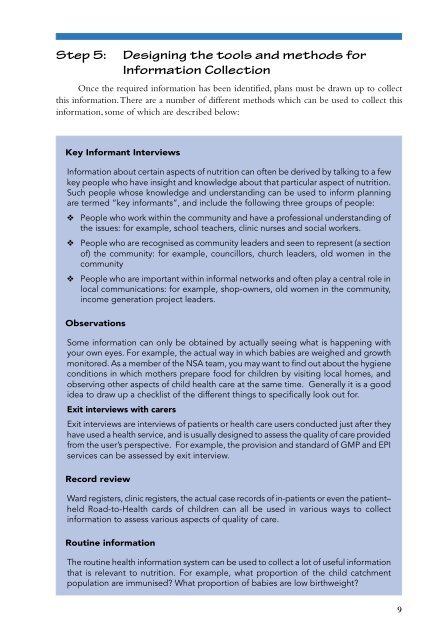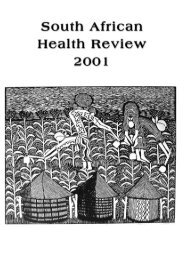How to conduct a rapid nutrition assessment - Health Systems Trust
How to conduct a rapid nutrition assessment - Health Systems Trust
How to conduct a rapid nutrition assessment - Health Systems Trust
Create successful ePaper yourself
Turn your PDF publications into a flip-book with our unique Google optimized e-Paper software.
Step 5:<br />
Designing the <strong>to</strong>ols and methods for<br />
Information Collection<br />
Once the required information has been identified, plans must be drawn up <strong>to</strong> collect<br />
this information. There are a number of different methods which can be used <strong>to</strong> collect this<br />
information, some of which are described below:<br />
Key Informant Interviews<br />
Information about certain aspects of <strong>nutrition</strong> can often be derived by talking <strong>to</strong> a few<br />
key people who have insight and knowledge about that particular aspect of <strong>nutrition</strong>.<br />
Such people whose knowledge and understanding can be used <strong>to</strong> inform planning<br />
are termed “key informants”, and include the following three groups of people:<br />
❖<br />
❖<br />
❖<br />
People who work within the community and have a professional understanding of<br />
the issues: for example, school teachers, clinic nurses and social workers.<br />
People who are recognised as community leaders and seen <strong>to</strong> represent (a section<br />
of) the community: for example, councillors, church leaders, old women in the<br />
community<br />
People who are important within informal networks and often play a central role in<br />
local communications: for example, shop-owners, old women in the community,<br />
income generation project leaders.<br />
Observations<br />
Some information can only be obtained by actually seeing what is happening with<br />
your own eyes. For example, the actual way in which babies are weighed and growth<br />
moni<strong>to</strong>red. As a member of the NSA team, you may want <strong>to</strong> find out about the hygiene<br />
conditions in which mothers prepare food for children by visiting local homes, and<br />
observing other aspects of child health care at the same time. Generally it is a good<br />
idea <strong>to</strong> draw up a checklist of the different things <strong>to</strong> specifically look out for.<br />
Exit interviews with carers<br />
Exit interviews are interviews of patients or health care users <strong>conduct</strong>ed just after they<br />
have used a health service, and is usually designed <strong>to</strong> assess the quality of care provided<br />
from the user’s perspective. For example, the provision and standard of GMP and EPI<br />
services can be assessed by exit interview.<br />
Record review<br />
Ward registers, clinic registers, the actual case records of in-patients or even the patient–<br />
held Road-<strong>to</strong>-<strong>Health</strong> cards of children can all be used in various ways <strong>to</strong> collect<br />
information <strong>to</strong> assess various aspects of quality of care.<br />
Routine information<br />
The routine health information system can be used <strong>to</strong> collect a lot of useful information<br />
that is relevant <strong>to</strong> <strong>nutrition</strong>. For example, what proportion of the child catchment<br />
population are immunised? What proportion of babies are low birthweight?<br />
9

















